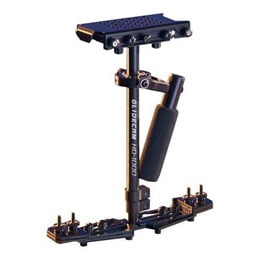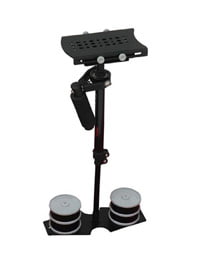When it comes to using gimbals, there are lots of different systems out there. Some are designed to handheld for running shots; others are designed to be attached to vehicles such as UAVs, whereas others are designed to be versatile to be used as stabilization units in a number of different ways. The Glidecam HD 1000 and the DVC 17837 DSLR Flycam Nano are two stabilization units that are both excellent options for independent filmmakers who need an affordable solution to their stabilization problems when filming handheld running shots.
Glidecam HD 1000

The Glidecam HD 1000 comes with a telescoping center post that doesn’t need tools in order to be adjusted, making it ideal for those who have a limited amount of time on location and need to be able to make adjustments quickly. It is also useful for those who are inexperienced using stabilization units. The off-set handle has a foam padded grip that makes it comfortable and easy to use. The positioning of the handle doesn’t throw off the balance of the unit and makes operating the Glidecam HD 1000 simple.
The Glidecam HD 1000 comes with a mounting platform, a mid-plate and a base plate. The rubber feet under the platform base mean it is unlikely to slip when it is used as a monopod. The Glidecam HD 1000, like the rest of the Glidecam HD series, has a three axis gimbal with a yoke and can bring a polished Hollywood look to bumpy running shots and even climbing stairs.
The Glidecam HD 1000 has unrestricted booming and 360 panning making it a great budget choice for independent filmmakers. The rig also comes with an integrated quick release system so that you can easily remove your camera unit from the rig with the smallest amount of fuss.
There is also dynamic camera balance platform that also you to customize the stability of the camera using the fine adjustment system and also comes with precision bearings at the vital points on the gimbal. The stability of the Glidecam HD 1000 can be adjusted using the 8 counterweight plates that each weigh 1.44lbs.
Flycam Nano

The DVC 17837 DSLR Flycam Nano is a similar style of stabilization unit to the Glidecam HD 1000. It has been designed to operate with DSLR cameras and camera/lens combinations. The DVC 17837 DSLR FlycamNano is a heavier unit than the Glidecam HD 1000 at 6.6lbs, and has a load capacity of between 3.3lbs and 4.4lbs, so it is perfect for using with medium sized cameras and their accessories.
The balancing system for the DVC 17837 DSLR Flycam Nano is quick and the gimbal is exceedingly easy to assemble. The camera platform can be adjusted in both the x and y axes so that you can capture different angles without having to use tools to take apart the rig and reposition the camera. This can save precious time and is especially useful if this is the first gimbal you have used.
There are multiple mount holes on the mounting plate so that cameras of different sizes can be easily mounted and cameras can be mounted in different positions for different shots. The base platform also comes with a ¼ inch fixture so that you can attach an LCD monitor or other camera accessory to the gimbal. The telescopic sled on the DVC 17837 DSLR Flycam Nano allows you to perfectly balance your camera on the gimbal.
The gimbal bearings on the DVC 17837 DSLR FlycamNano have been specifically designed so that they are compatible with nearly all Canon cameras. This includes the Canon 5d Mark II, the Canon EOS7D, the Canon 1000D, the Canon 40D, the Canon 50D, the Canon 450D, the Canon 60D, the Canon 1100D, the Canon 30D, the Canon 20D, the Canon 350D and the Canon 450D. The DVC 17837 DSLR Flycam Nano comes with sixteen weight discs that can be used to customize the stability of the gimbal and can be affixed to the base platform.
The Final Verdict
Both the Glidecam HD 1000 and the DVC 17837 DSLR Flycam Nano are both great stabilization units for small independent productions, or even for using to create more professional looking home movies. The ability to pan, tilt and boom smoothly is something that is well worth paying for, but with both these basic models, it doesn’t cost the earth. The DVC 17837 DSLR Flycam Nano is the cheaper of the two, so if it is the cost of the unit that is the deciding factor, then it is the better choice.
The Glidecam HD 1000 has the advantage over the DVC 17837 DSLR Flycam Nano in the design of its 3 axis gimbal and the superior load capacity. If you have a little extra money in your budget then the Glidecam HD 1000 is well worth investing in. The stability of the Glidecam HD 1000 is harder than the DVC 17837 DSLR Flycam Nano as it only comes with 8 counterweights compared to the 16 counterweights of the Nano. Yet both units will provide filmmakers with smooth shots and remove the jerky and shaky imaging that can ruin an independent production without any reason to.
Click here to purchase Glidecam HD-1000 on Amazon!
Click here to purchase Flycam Nano on Amazon!